A BRIEF HISTORY OF PHOTOGRAPHY
by Joelle Steele
 I grew up in the era of film cameras. My mother gave me her old 1940s Ansco when I was about 10 years old, and I don't even remember any time after that when I didn't have a camera. I had several 35 mm ones -- Minolta, Pentax, Leica, Nikon, Canon, and Yashica. All great cameras, but I finally settled on three old Rollei cameras with Zeiss lenses: a 1960 "Baby" Rolleiflex, a 1969 35mm Rollei, and another Rollei SLR that produced small square negatives. Today, I have forsaken all my film cameras in favor of my digital ones, and many people have turned to the digital camera as the best camera for their daily and professional needs. It's really amazing to think how far cameras and photography have come.
I grew up in the era of film cameras. My mother gave me her old 1940s Ansco when I was about 10 years old, and I don't even remember any time after that when I didn't have a camera. I had several 35 mm ones -- Minolta, Pentax, Leica, Nikon, Canon, and Yashica. All great cameras, but I finally settled on three old Rollei cameras with Zeiss lenses: a 1960 "Baby" Rolleiflex, a 1969 35mm Rollei, and another Rollei SLR that produced small square negatives. Today, I have forsaken all my film cameras in favor of my digital ones, and many people have turned to the digital camera as the best camera for their daily and professional needs. It's really amazing to think how far cameras and photography have come.
PHOTOGRAPHY'S EARLIEST ROOTS
Camera history began with what later became known as the "camera obscura," a Latin term meaning "dark room" — and the first ones were almost room-size. The camera obscura was a large dark box with a hole in one end which, if small enough, would produce an inverted image opposite it. The concept of the camera obscura can be seen in a 16th century drawing by Leonard da Vinci, but the basic principles of the device date back to much earlier centuries when they were used to observe solar eclipses. Hundreds of years before da Vinci, the 10th century Arab scientist, Abu Ali al-Hasan (or Alhzaen) ibn al-Haytham (or al-Haitam or al-Basri), author of "The Book of Optics," described the camera obscura and the pinhole camera in his writings, and was the first to project an image from outdoors onto a screen indoors using the camera obscura. By da Vinci's time, the camera obscura was primarily advocated as a drawing tool for artists.
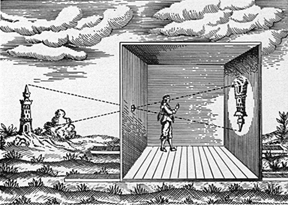
As an artist's tool, the camera obscura or pinhole camera could project a scene onto paper, which the artist could trace, allowing for a greater degree of accuracy in perspective and detail. This was quite a tool, since the artist had to be inside the box to use it. And it was very expensive. Although many artists felt it was an affront to their artistic talents, some well-known artists were believed to have used the camera obscura in their works. Eventually, smaller versions were made available, and the camera obscura became more widely accepted by artists.
During its earliest years, the camera obscura had its shortcomings, noticeably the lack of a lens to create a clear image. The lens was probably invented by the 16th century mathematician, Girolomo Cardano (a.k.a. Jérôme Cardan, Gerolomo Cardana) of Milan. He was supposedly the first to either mention the use of a biconvex lens with a camera obscura in 1550, or the first to place a convex glass lens into the pinhole of a camera obscura. However, Roger Bacon was likewise given credit for contributing to the invention of the lens. Despite all that was being developed with regard to the camera obscura, it was still a long way from being a camera as we know it today, because there was yet to be a means of chemically fixing the image it produced.
THE FIRST PHOTOGRAPH - HELIOGRAPHY
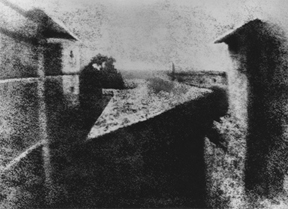
PHOTO #2: First Photograph, 1826 by Joseph Nicéphore Niépce (above).
It was known in the 17th and 18th centuries that silver chloride, powdered silver nitrate, and certain liquids, either turned dark or changed color when exposed to light. Several people experimented and even managed to capture images with the use of chemicals. But, the ability to fix an image photographically is generally attributed to Joseph Nicéphore Niépce. He began experiments in fixing images around 1816 in France. He first fixed an image in 1822, and in 1824 took a photograph that required a 5-day exposure on stone.
In 1826, Niépce created the first photograph. It was taken by Niépce at his family home in Saint-Loup-de-Varennes and required an 8-hour exposure. He called his process "heliography," and he continued to experiment with fixing images to silver plates and silver-coated copper plates using sodium iodide fumes. In 1829, he partnered with Louis Jacques Mandé Daguerre, an artist with some architectural training. Daguerre had used a camera obscura in his art and wanted to be able to fix the image, and that led him to work with Niépce. When Niépce died suddenly in 1833, Daguerre continued working on the process.
DAGUERREOTYPES
In 1837, Daguerre found a way to fix the image by rinsing the plate in salt water, later thiosulfate of soda (modern photography's "hypo" fixing solution), the latter as the result of Sir John Herschel's 1819 discovery of its properties which he announced to Daguerre and Talbot in 1837, and to the public in 1839. This process reduced exposure time to approximately 30 minutes, making it a much faster process, although still rather long for portraiture. Daguerre named his photographs "Daguerreotypes" and he first introduced the process in Paris and NYC in 1839.
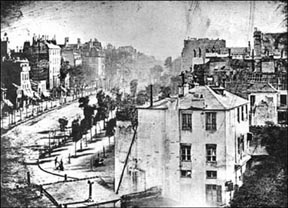
PHOTO #3: 1839 Daguerreotype, Boulevard du Temple, by Louis Daguerre, 1838/39, original (above).
In this very early Daguerreotype (above), the street appears to be deserted because the exposure took so long that anything moving was not captured. The image shows a man having his shoes shined in the lower left-hand quadrant of the photo. It is believed to be the first photograph of a person.
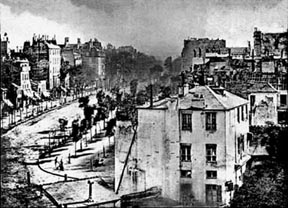
PHOTO #4: Digital Restoration (above).
At the base of the white building in the foreground, there was a bright white area. In this digital restoration, I burned this white area to reveal two people standing in front of a doorway.

PHOTO #5: Enlargement of White Area (above). It appears to be a woman (on the left) and possibly a man.
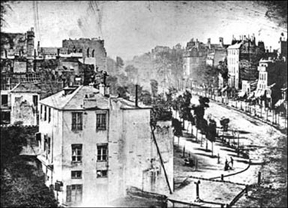
PHOTO #6: Laterally reversed image (above).
Daguerrotypes had an issue that many don't know about. The images were laterally reversed. The same was true with tintypes. This means that while the images are close approximations to the appearance of the subject, to see what a person or place really looked like, it has to be laterally reversed (above).
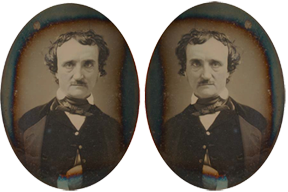
PHOTO #7: Daguerreotype of Edgar Allen Poe (above).
The original Daguerreotype of Poe (above left) is his mirror image. The laterally reversed, corrected photo, is on the right. By digitally reversing the image, you can see what the person really looked like (no one's face looks exactly the same in reverse, as can be seen in Poe's images).

PHOTO #8: Daguerreotypes (above).
The Daguerreotype camera's small aperture lens combined with long exposures resulted in showing off the fine details of the subjects photographed. Daguerreotypes, which were one-of-a-kind positive images, were popular until about the mid-1850s, at which time they began to be replaced by ambrotypes and tintypes. However, Daguerreotypes were still favored for their high contrast images and exquisite details. Many were still being made well into the 1920s. You can tell if you have a Daguerreotype because its surface is like a mirror and you have to hold it at a slight angle to see the image clearly.
SALT PRINTS AND CALOTYPES
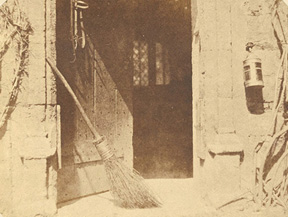
PHOTO #9: "The Open Door," 1844, by William Henry Fox Talbot (above). A salt paper print from a calotype negative.
Back in 1834, while Daguerre was still refining his process, William Henry Fox Talbot was making the first photographic prints — salt prints — from negatives. A negative was produced by dipping paper in a salt solution, floating it in silver nitrate, exposing it, the rinsing with water and fixing with sodium thiosulfate. The print was made the same way by exposing paper to sunlight through the negative. Talbot then started making "calotypes" which made the negative inside the camera and then required a chemical developer after which the salt print process was used to make the print. This is the precursor to the film camera. Unfortunately, salt prints had poor resolution and they faded, so they were not a viable photographic process and few have survived.
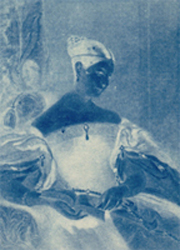
PHOTO #10: "The Honourable Mrs. Leicester Stanhope," cyanotype, by Sir John Herschel (above).
In 1842, Sir John Herschel, the man who coined the terms "positive" and "negative," discovered the cyanotype, a non-silver iron process. The name cyanotype comes from the color "cyan," as these permanent images had blue coloration. They are one of the forerunners of our modern blueprinting process. Herschel is also credited with the discovery of the platinum process which was later developed by William Willis, Jr. who introduced it in 1874.
WET COLLODION PROCESS & AMBROTYPES
In 1850, Frederick Scott Archer, a silversmith and sculptor, and a man named Peter Fry, developed a photographic process that came to be known as the wet plate collodion process, and which was still in use well into the 1960s in the printing industry. It is said that Archer and Fry invented the process simultaneously with French photographer Jean-Baptiste Gustave Le Gray. Archer's alternative to the calotype and Daguerreotype processes came to be known as the ambrotype (left), probably named for James Ambrose Cutting, an American photographer who took out patents for improvements on Archer's process. The process was similar to Daguerre's, but used a glass plate coated with potassium iodide and collodion and bathed in silver nitrate. The plate then had to be exposed while still wet. It was developed in a solution of ferrous sulfate and fixed with potassium cyanide.

PHOTO #11: Ambrotypes (above).
Ambrotypes required a shorter exposure time that resulted in less details than a Daguerreotype, but a still highly recognizable subject matter that was not laterally reversed. And ambrotypes were negatives that required a dark backing to be viewed properly, so like the Daguerreotypes, they were encased. Ambrotypes were low contrast, grayish, and often hand-tinted. Some people refer to them as looking "stormy." They were popular between about 1855 to 1860, when they were replaced by the Cartes de Visite which had been originally introduced in 1854 by French photographer André Adolphe Eugène Disdéri. They were an alternative to the embossed or printed calling cards of years earlier, and could be printed on paper in quantity.
UNION CASES

PHOTO #12: Hinged Union Cases (above).
Daguerreotypes and ambrotypes were first encased in wooden boxes with brass mats. But in 1853, the hinged "Union Case" was introduced by Connecticut Daguerrian Samuel Peck. It was made of a thermoplastic compound. Today, we refer to all photographic cases as "union cases." Many were made by numerous manufacturers who marked their cases.
TINTYPES
In 1853, tintypes (earlier called melainotypes and ferrotypes), were invented in France by a teacher, Adolphe Alexandre Martin. The process was then patented and produced in 1856 in the United Kingdom by William Kloen and in the United States by Hamilton Smith. Like the ambrotype, tintypes were wet plates, the difference being that the plate was made of a thin sheet of iron instead of glass and multiple exposures could be made of a single plate. The two processes are not easily distinguishable at first sight, both being rather dark images, and a quick test to determine the difference is by using a magnet to attract the iron in the tintype.

PHOTO #13: Tintypes (above).
The images in tintypes were, like Daguerreotypes, laterally reversed. Tintypes were all the rage during the mid-1860s in the United States, after which they were being replaced by the newer dry plate emulsion process. But tintypes were still in widespread use in the US during the 1880s, during World War I, and into the 1920s. They were especially popular with soldiers during the Civil War because they were so affordable and durable. They never quite caught on in Europe where they were considered a novelty.
ALBUMEN PRINTS
In 1848, the nephew of the late Joseph Nicéphore Niépce, Abel Niépce, used albumen (egg whites) salted with potassium iodide which was applied to glass, exposed to silver nitrate, exposed to light, and then developed with gallic acid. It worked but was impractical because of its long exposure time. In 1850, Louis-Désiré Blanquart-Evrard, a French photographer, created albumen paper, a slow-print paper that produced an image on exposure without a chemical developer. Albumen prints have a glossy finish, the image resides on the paper rather than in it (as did the salt prints), and there is increased detail in the image. Because the paper is so thin these photos tend to curl, so most are attached to card stock. Albumen paper was the most widely used photo printing material from about 1855 to the mid-1890s, and was still in use as late as the 1920s.
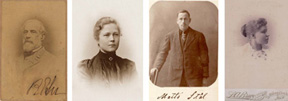
PHOTO #14: Cartes de Visite (above).
During the earliest days of photography, portraiture was, as it is today, the most popular use of the medium. But it was quite difficult to achieve a clear image because the exposure time was so long and the contrast of the image was poor. People who had their photographs taken spent a great deal of time preparing themselves to look as good as possible, wearing their finest clothes, having their hair styled, displaying their fine jewelry, etc. But photographers had to convince them to avoid wearing clothing that was overly dark or overly light, as the long exposure made darks darker and lights lighter. And there was the problem of movement creating a blur, so many photographers utilized head restraints to keep their subjects still during the lengthy period of exposure.
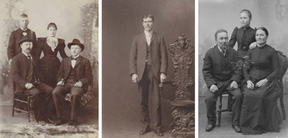
PHOTO #15: Cabinet Cards (above).
The Cartes de Visite and cabinet cards were albumen prints. While many of these images still exist, they are often quite faded from their original purple/mauve color to a yellow/brown, and are additionally stained yellow or brown in the non-image areas.
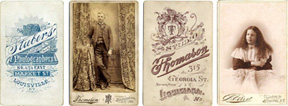
PHOTO #16: Decorative labels for cards (above).
Cartes de Visite and cabinet cards often had a decorative reverse side that showcased the photographer or his/her studio.
STUDIO BACKDROPS
In about the mid-1800s, as photography became more accessible to people, artist-painted backgrounds became popular. They made it look as if the subject was in a beautiful room, a garden, an exotic locale, etc.
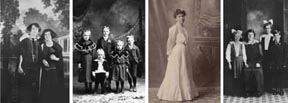
PHOTO #17: Photos with decorative backdrops (above).
STEREOVIEW PHOTOGRAPHS
In 1850, the first stereoscopic or stereoview photographs, also once called stereotypes, were taken by Louis Jules Duboscq, a French optician. He used a camera with two lenses to produce two images of an object or landscape taken about 2.5" apart which were then viewed together through a viewer (a stereoscope) that displayed both images as one, creating a sense of depth.

PHOTO #18: Stereoview Photographs (above).
This was a 16th century process that had previously been used only with drawings. The camera process was patented in 1853 by photographer Antoine Claudet, who later invented a folding stereoscope and belt viewer that allowed for a hundred images for be viewed in succession. Stereoview or stereoscopic photographs were albumen prints on paper, and hundreds of thousands were made during the latter half of the 19th century, many sold in catalogues.
PANORAMAS
The first panoramic photo camera was invented in 1843 by an Austrian, Joseph Puchberger. It was a hand-crank-driven swing lens camera. It allowed detailed photographs to be taken of landscapes and citiscapes, as well as large groups of people.
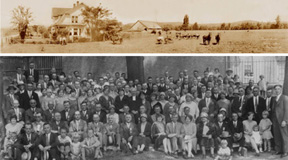
PHOTO #19: Landscape Panorama (above).
PHOTOGRAPHY AS ART
Photography also had the potential to create art. Yet, it is hard to believe today that during Daguerre's lifetime and even into the late 19th and early 20th centuries, photography was increasingly popular but was not always considered to be an art. Its critics believed that because the camera was a mechanical device that it could not be used to interpret subject matter artistically, and it is this artistic interpretation that comprises the traditional definition of what is considered "art."
To circumvent this problem, many photographers found ways to make their photography more artistic. They turned to darkroom techniques to enhance their images by layering multiple negatives to produce composite prints, softening or blurring images and darkening others, and by drawing on negatives with brushes and pens or using sharp objects such as needles or fine knives to etch lines into their images for artistic or graphic effect. These photographic artists were known as "pictorials," and they were opposed by another faction of photographers who believed photography was a pure art without the need for such techniques, and that retouching was not necessary as a photographer could wait for the right light effects, etc., to achieve photography as art.
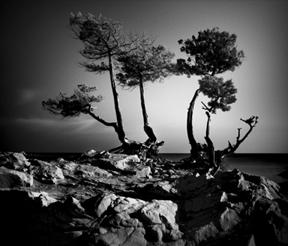
PHOTO #20: Long exposure art photograph by French photographer Philippe Mougin (above).
Then there were those who simply believed that not only was photography not art, but it was most likely the invention of the devil. Despite such objections, photography became extremely popular, even more so upon the introduction of the dry plate process.
COLOR PHOTOGRAPHY
In 1861, the first color photograph, a "trichrome," was made by James Clerk Maxwell, a Scottish physicist and mathematician. His theories of electromagnetism and light as energy waves led him to create the trichromatic process. He used colored lenses in red, green, and blue and took three photos of the same image, then projected the three images onto the same surface to create a color image.
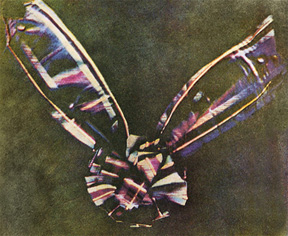
PHOTO #21: First color photograph (above).
AERIAL PHOTOGRAPHY
In 1858, the first aerial photograph was taken from a tethered balloon in France by Gaspar-Félix Tournachon (a.k.a. Félix Nadar or simply "Nadar"). Sadly, that image is lost, but a later Nadar aerial of Paris taken in 1868 still exists.
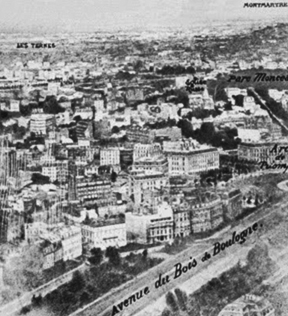
PHOTO #22: First aerial photograph of Paris, 1868 (above).
DRY PLATE PROCESS
The introduction of the dry plate process revolutionized photography and eliminated the need for cumbersome equipment. The dry plate process had been invented in the mid-1850s by Dr. Richard Norris, a British professor of physiology at Queen's College in Birmingham, England. It used a gelatin-based emulsion. But it did not received adequate attention until 1871, when British physician and photographer Richard Leach Maddox wrote an article about it in the "British Journal of Photography." The process was later perfected by George Eastman of Rochester, New York.
In 1877, Eastman bought his very first camera. Within two years, he had perfected his own dry-plate method, received a patent for it in 1880, and started a partnership with Henry Strong in 1881 called the Eastman Dry Plate Company. In 1883, he created flexible film in which the gelatin and chemicals were put on rolls of paper. This was followed by his invention of a not-so-successful camera in 1886, and the amazingly successful box camera in 1888, the year that photographic film was introduced by John Corbutt. A year later, in 1889, roll film was invented by Eastman.
KODAK CAMERAS
The first daylight loading film was introduced by Eastman Kodak in 1894, and by 1896, Kodak had produced more than 100,000 cameras. In 1898, Kodak introduced the first "folding camera" and in 1900 sold the first mass-produced and affordable camera for the public, the Brownie.
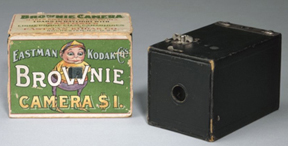
PHOTO #23: The Brownie by Kodak (above).
Photography was now officially in the hands of anyone who wanted to pursue it and could afford to do so. Most photographs were still made in the studio by professionals, but many of them took their cameras outside and around the cities and rural areas where they documented people, places, animals, events, and common everyday objects. The photographic process, unlike its earliest predecessor, the camera obscura, was no longer an adjunct to art. It had become an art in and of itself.
PHOTO BOOTHS
The 20th century saw numerous camera manufacturers battling to serve the growing needs of people for affordable, simple, hand-held cameras. Photo booths became popular after they were invented in 1925 in New York. They were in widespread use within two years. They were easy to find in almost every city and town, were easy to use, fairly inexpensive, and usually allowed you four photographs (on a strip that came out of a slot). Couples and groups of people - however many could fit in the booth - would all get inside to to take their photos.
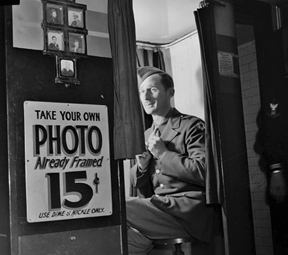
PHOTO #24: Soldier in New York, 1943, in a photo booth getting ready to take his photo (above).
POLAROID PHOTOGRAPHY
In 1946, American physicist Edwin H. Land invented Polaroid photography, a one-step ("instant") photographic process. The first Polaroid camera was created and sold in 1948. In 1960, the Automatic 100 Land Camera was created, followed five years later in 1965, with the black-and-white Polaroid Swinger which sold for $19.95. The ease of operation was pointed out in part by the Swinger's TV jingle: "Swing it up, it says yes, take the shot, count it down, zip it off." The picture developed partially in the camera and was removed by the (amateur) photographer after a certain number of seconds. Polaroid images (left from 1961) were, on the whole, pretty poor quality, with few details, streaks, over/under-exposed areas, and often blurry images. The photos came in rectangular and square sizes similar to other print sizes of the snapshots common to the second half of the 20th century.

PHOTO #25: Polaroid photos (above).
Kodak went into the instant photography business and was sued by Polaroid in 1976 for patent infringements, which ultimately put Kodak out of the instant photography business by 1985.
By the 1960s, you would have been hard-pressed to find any household without a camera, and even more so today in the 21st century, when filmless digital cameras are available in all shapes and sizes, from simple point-and-shoot versions to ones that rival the sophistication of the finest 35mm cameras. I will always remember the wonderful film cameras I once used and all their fantastic filters and other accessories. But with computerized photo editing and the speed, flexibility, and sophistication of the digital camera, I had to bid them all a fond adieu.

